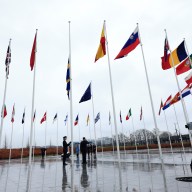 Credit: Shawn Tan
Credit: Shawn Tan
Scientists have reproduced a famous Impressionist painting using nano-printing, to create what has been described as the world’s smallest work of art. Reworked at the Singapore University of Technology and Design, the copy of Monet’s “Impression, Sunrise” measures 300 micrometers in size, about the width of two strands of hair. Shawn Tan, a scientist at the Institute of Materials Research and Engineering in Singapore, explains to Metro how they duplicated Monet’s masterpiece at a nano scale.
Wow, how did you do this?
We used aluminum-topped silicon pillars – built at a nanoscale – that when they interact with light emit electrons that in turn produce colored light. Four of these pillars would make up a “pixel,” and by varying their diameters we were able to create a palette of over 300 colors.
What were the challenges in duplicating Monet’s masterpiece?
We had limited colors with aluminum nanostructures. Without pigment-based colors, we had no well-defined palette or color schemes. And so, we had to study and understand how to generate new colors with nanostructures, by manipulating their size and positioning. It took us months to solve that alone.
Months? So you worked like a real artist then …
Indeed, but it took only two hours to print the nanoscale structures for the final microprint.
Why Monet?
Claude Monet was a pioneer of Impressionism, and the painting we chose to copy was the one that gave rise to the name of the Impressionist movement. In the same way, we hope that this technology will pave the way for a new generation of high-resolution prints. Monet’s works were composed of very detailed characteristics such as the form and flow of his brush strokes, which we felt was a worthy challenge to duplicate.
What do you think Monet’s reaction would have been?
For an artist renowned for his brush strokes, I think he would be enthralled at how an entire painting could fit into the finest brush stroke the size of a strand of hair.
Based on what you have done here, what are the benefits of nanotechnology?
We envision this work to have a direct impact in security and counterfeiting applications, as well as in product branding and authentication. This technology could be further extended to holography and data storage applications as well.
It’s hard to tell the original and copy apart.
We have definitely moved forward by leaps and bounds in printing technology. To the casual observer, the reproduction would look identical in the digital form. However, with the proper tools, experts would be able to discern that the source of the color is from carefully-patterned nanostructures rather than microsized dye droplets. This reproduction could really be perceived as art in a different modality.
















